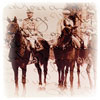Captain Alfred Herbert “Bert” John Andrews, MC, was born in Troy, District of Assiniboia, North-West Territories (present day Qu’Appelle, Saskatchewan), in October 1880. Prior to his enlistment he was living in Winnipeg, Manitoba, where he worked as a barrister.
Andrews enlisted with the 34th Fort Gary Horse at Valcartier, Québec, on September 24, 1914. As part of the First Canadian Contingent, Andrews sailed for England on board the SS Lapland on October 4, 1914. He shipped to France in May 1915, where he joined the 10th Battalion. His first experience in the trenches was near Festubert, France, followed by a brief time at Hill 63, then nine months spent at Messines.
Commissioned as an officer on January 13, 1917, Andrews began serving as Lewis Gun officer in February. The following April, at Vimy, he was in charge of overseeing Lewis Gun positioning, equipment and training. He served as Adjutant beginning on October 28, 1917. While fighting in France with the 10th Battalion, Andrews was twice awarded the Military Cross, first on October 18, 1917, and again (as bar to Military Cross) on February 1, 1919. On the second occasion the London Gazette included the following description with the announcement of his award:
“For conspicuous gallantry and devotion to duty at Villers-les-Cagnicourt and the Canal du Nord, 2nd to 4th September, 1918. He went into the attack in command of the battalion reserve company, and later was sent forward to command one of the leading companies. He handled his command splendidly, and pushed forward to the battalion final objective at the Buissy Switch, and redistributed his men with exceptional skill. The following day he led his company forward, and, under very heavy fire, established a line along the railroad west of the Canal du Nord, from which they could command all the intervening ground. He did excellent service.”
While serving overseas Andrews married Alice “Allie” Dixon on September 16, 1918. Alice accompanied him on his return to Canada, sailing together from Liverpool on April 23, 1919, abord the SS Metagama. Andrews was demobilized the following month, in May of 1919.
Content notes:
Andrews kept diaries throughout WWI, covering August 1914 to December 1918. Around 1923 or so he used these diaries to create a complete typewritten history of his time in service, beginning with his enlistment and ending with 10th Battalion’s month-long post-Armistice march across Belgium to the Rhine Bridgehead position inside occupied Germany.
The diaries are rich in descriptive and explanatory detail, covering time spent in both non-commissioned and commissioned officer ranks. Significant places/events covered are: 1st Contingent at Valcartier, SS Lapland, Salisbury Plain Camp, Festubert, Hill 63, Messines, Ypres, Blendecques O.T.S., Vimy, Hill 70, Buissy Switch, Passchendaele, Battle of Amiens, and post-Armistice Belgium and Germany.
External links:
Cpt. Andrews’s service record (Serv/Reg# 14502 and 14506) can be viewed/downloaded in pdf format through Library and Archives Canada.
The first awarding of the Military Cross to Andrews was published in The London Gazette on October 18, 1917 (#30340, p. 10712); his Bar to Military Cross was published February 1, 1919 (#31158, p. 1631).
[Editor’s note: Collection reviewed/updated April, 2023. Jpg files of Andrews’ original typewritten document have been added, as well as one additional photo. Diary transcriptions and content descriptions reviewed and amended. Collection Description updated and expanded.]




